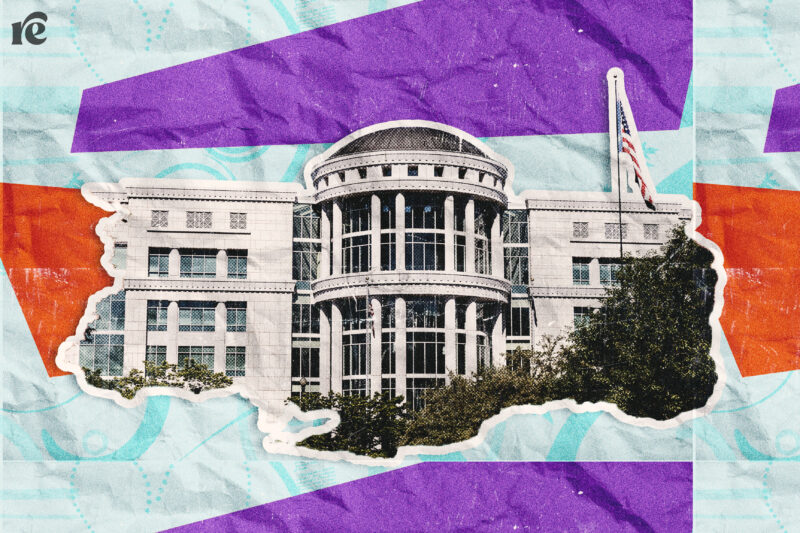State Supreme Courts Step Up in the Fight to Rebuild Access After ‘Roe’
Utah just showed that state supreme courts are the new abortion rights battleground.

Move over, SCOTUS. State supreme courts are increasingly taking center stage in the fight for abortion rights and access.
In the span of two weeks, state supreme courts in Nebraska, Iowa, and Utah all weighed in on abortion bans in their state. The Nebraska Supreme Court upheld its state’s 12-week ban. The Iowa Supreme Court allowed the state’s six-week ban to take hold. And on Thursday, the Utah Supreme Court bucked the trend and ruled to keep in place an injunction blocking a 2020 law that bans all abortions in the state except in three narrow circumstances. Thursday’s ruling means abortion remains legal in Utah up to 18 weeks while the lawsuit challenging the 2020 ban continues in the lower courts.
These rulings will collectively shift an already-fluid abortion access map. As Garnet Henderson reported for Rewire News Group, access in the Midwest was already precarious. The Nebraska and Iowa rulings will only make that worse. By contrast, the Utah Supreme Court decision to keep that ban blocked offers a temporary reprieve from reduction of access for the Rocky Mountain West.
But the rulings do more than strain the contours of the abortion access map—they also refine the constitutional conversation around abortion access entirely.
State supreme courts play an important role post-Dobbs for another reason: electability of judges.
Prior to the Supreme Court’s decision in Dobbs v. Jackson Women’s Health Organization, abortion rights were understood primarily in a federal context, as defined by the Constitution. That’s not to say that state courts and constitutions didn’t matter before Dobbs. In states like Kansas and Oklahoma, they certainly did. But by overturning Roe v. Wade, the Supreme Court made sure those state supreme courts mattered everywhere. And in the short term, that could be a good thing for efforts to restore abortion rights nationwide.
According to analysis by the Center for Reproductive Rights, 12 state high courts currently recognize the right to abortion as found in state constitutions in some form. Only four—Iowa, Idaho, Indiana, and South Carolina—have ruled their state constitutions do not protect abortion generally. And in regions of the country where abortion access is already hanging on by a thread, it’s been state supreme courts and constitutions providing a much-needed lifeline while the country rebuilds after Dobbs.
In fact, it is state constitutions that currently offer the most robust abortion protections, as well as the building blocks for a new jurisprudence forward. Take Pennsylvania, for example, where the state supreme court relied on the Pennsylvania Equal Rights Amendment in the state constitution to wipe away decades of anti-abortion precedent and clear the way for Medicaid funding for care.
Prior to Dobbs, the Kansas Supreme Court determined that its state constitution’s embrace of natural law includes a broad right to abortion—a far more progressive holding than anything the Supreme Court has ever contemplated nationally. Federal lawmakers trying to rally voters around a plan to “Restore Roe” should instead spend their time making the case for how to device a national strategy built off Pennsylvania’s success and the popularity of abortion rights ballot initiatives rather than a middling congressional response that, even if it were to pass, would remain vulnerable to the most abortion-hostile Supreme Court in history, as well as repeal by a future Republican administration. Advocates looking to craft refreshed constitutional arguments recognizing bodily autonomy will currently find more expansive framings from the Kansas Supreme Court than anywhere else in the country. When it comes to rebuilding abortion access after Dobbs, states courts and constitutions can function as those incubators of democracy.
State supreme courts play an important role post-Dobbs for another reason: electability of judges. Twenty-four states elect their state supreme court judges in a mix of partisan and nonpartisan elections. In places like Wisconsin, that mix of electing judges and protecting abortion rights and access has created an important firewall against never-ending legislative attacks on reproductive autonomy. It’s also seen in Florida, where the fight for control over the state supreme court and abortion access are all wound up in the current ballot initiative over abortion rights in the state.
In overturning abortion rights in Dobbs, the Supreme Court upended much of the relationship between the federal government and the states. In forging a path forward, advocates and lawmakers are right to look to state courts and constitutions in building something better and more robust than Roe.
